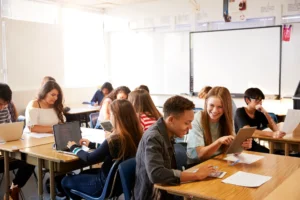Kids are headed back to school soon, and for kindergarteners, they may be starting school for the first time. As a school leader or parent, you may be a little, or for parents, very nervous about their first day in school. School safety needs to be a top priority for superintendents, principals, staff, teachers, and parents. The faculty at most schools are not only trained on school security practices, they are also trained to talk to students in an age appropriate manner without scaring them. This training is invaluable as they guide the children on fire drills, tornado drills and armed intruder drills.
School Safety Tips
The first few days of school can be really hectic for school leaders and parents. That said, most school leaders appreciate involved parents and embrace the opportunity to work together with them. Parents should talk to their child’s teachers or school principals about school safety plans. While some schools may hesitate to share every part of their plans and strategies, everyone should be aware of the information available to them. Being prepared will be an asset in the event something goes wrong.
School leaders and parents should talk to the kids about emergencies at their age level. Young children need simple information that is not overwhelming or frightening. Balance the new and potentially scary information with reassurance. Let the children know that their school is safe, and that adults are available to protect them. While this may be difficult, don’t get too emotional. Young children often gauge how threatening or scary an event is by an adult’s reaction. Holding back your emotions help to reinforce the idea that school is a happy, fun, and safe place for your child.
Terms to learn before the first day:
Here are a few terms by healthychildren.org that may be helpful to know before going back to school.
Evacuation: Used to move everyone out of the building. An evacuation is when everyone leaves the building and moves to a nearby pre-designated safe location. Schools practice evacuations regularly during fire drills.
Relocation: Moves everyone to a pre-designated offsite location following an evacuation. Depending on the time of day and the circumstances, students could be released to go home or moved to another building. Plans are also typically in place for students and staff who may need assistance moving to the relocation site.
Shelter-in-place: Typically used during severe weather such as a tornado. This is a precaution aimed to keep people safe while remaining indoors.
Lockdown: Used when there is a potential danger inside the school. A lockdown includes securing each room by locking the doors and directing everyone to move away from windows and doors. Typically, local law enforcement arrives to secure the site and arrange for evacuation.
Lockout: Used to secure the school from a possible threat outside the building, such as when an unauthorized person is on the grounds. During a lockout, access to the building is restricted, but there may be some limited movement within the building.
Understanding these terms and precautions can help prepare the children for the first week of school. Any school leader will tell you, proper preparation can prevent a panic and keep the situation under control. These ideas and drills can seem scary to parents as well as children, but taking precautions and planning for emergencies can actually make children feel safer in an emergency situation.
How SchoolGuard Helps Protect Schools
At Guard911 our mission is to protect the unprotected. Our SchoolGuard app is used by staff in many schools. In the event of a highly violent act such as an active shooter, approved school personnel can use the SchoolGuard app to press a panic button. This sends an alert to all mobile devices of federal, state, and local law enforcement participating in the Hero911 Network. The SchoolGuard app also alerts everyone at the school that carries the app, and connects the individual that pressed the panic button to 911.
Every school handles emergencies differently, so the best thing to do is educate yourself and be prepared. Talk to the children, and let them know they are safe and have people looking out for them. Help them understand that emergencies happen but they are surrounded by people who will work to ensure their safety. Teachers, administrators and the local police all work to make sure that school is a safe place to be.





